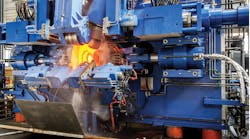Forging process technology evolves slowly, with concepts moving into development only as quickly as engineers can define the objectives — and into production only as quickly as manufacturers establish the opportunity, and gain the confidence of customers. But simulation and process control technologies seem to be speeding up the process, and the past year has seen a series of practical advances in forging production.
For example, in September Schuler AG introduced the first linear hammer powered by servo technology at RUD-Schöttler, a forger in Hagen, Germany. The concept had been introduced just a few months earlier, offering greater accuracy in the hammer movements than is achieved by hydraulic, pneumatic, or other power sources.
“Thanks to the new drive system, the hammer is not only regulated absolutely accurately, but also used in controlled operation more precisely than ever before,” explained Jochen Früh. Schuler’s managing director. “The ability to precisely position and flexibly control the slide opens up completely new possibilities – not only for precision forging, but also in terms of energy efficiency.”
By managing the energy of the hammer’s impact and its slide control, the patented hammer drive does more than improve process precision: it is able to maintain that accuracy with less than 1% divergence through repeated blows. “The new drive technology even offers the possibility of precision forging without impact areas,” according to Thomas Hüttenhein, general manager of RUD-Schöttler, whose operation is participating in a pilot program for the process, backed by Germany’s Federal Ministry for the Environment. “This eliminates the previously standard hard-on-hard blows for balancing temperature and material fluctuations.”
The electronic control system automatically adjusts the energy input and number of forging blows necessary to achieve the actual forging result after each blow – until the preselected part thickness is achieved. As such, the influence of engraving wear on part accuracy can be compensated by regulating energy input. This improves product quality and makes it possible to document process data continuously.
For forging operations, Schuler’s new drive technology offers maximum flexibility in adapting specialty forging products and processes. By eliminating die-to-die, hard-on-hard blows, the total number of forging blows can be reduced, which will reduce cycle times and energy requirements.
In coordination with a non-contact, maintenance-free linear drive, which directly converts electrical energy into the mechanical movement of the hammer slide, Schuler forecasts potential energy savings up to 20%.
Also, precise control of the upper slide makes it possible to integrate stretching and rolling blows, as well as bending operations, into the hammer forging process. In the case of low impact energies, the linear motor can be started from any position and thus also reduces cycle times by eliminating unnecessarily long slide strokes. This will increase the number of potential applications for the process.
Furthermore, the ability to control the linear drive with precision makes Schuler’s linear hammer a good candidate for robotic automation.
Finally, because need for all the systems and machinery used to generate compressed air or hydraulic energy, maintenance for the forging hammer is considerably reduced.
“By avoiding hard-on-hard blows on the impact surfaces, the load on die and hammer is also drastically reduced. This leads to a reduction in noise emissions and thus opens up the possibility – in combination with conventional soundproofing – of three-shift operation,” Thomas Hüttenhein stated.
















